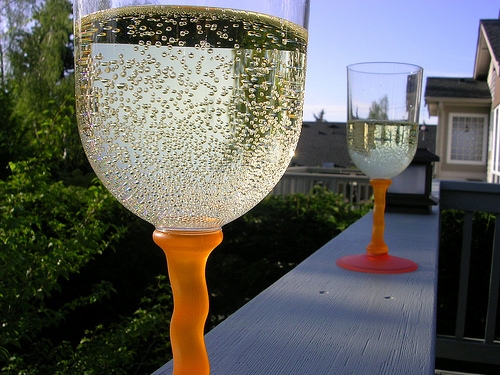August 31, 2011 —
Over the weekend I had a perfectly refreshing Vinho Verde. It was a perfect heat buster wine for a blistering August day in Texas. I got to thinking about this wine, where it comes from and how it came about in the first place. It is a unique style of wine originally created in the Minho region of Portugal to be consumed by those who live there and initially not grown to export. Vinho Verde is light, semi-dry to dry, low alcohol, acidic with a bit of C02, and served cold. The winemakers developed a style of wine that fit their culture. Portugal has hot summers, but they also get a lot of rain and rot pressure, encouraging an early harvest. The wine has a high acidity along with a lower alcohol content. There is no aging process, and they are bottled quickly making for a wine that is readily consumable, easy to drink and refreshing on a hot day in Portugal…Oh wait – make that everywhere!

The consumption of Vinho Verde has been growing by 30+% the last few years in the US. Why? The wine is light. Has a low alcohol content. Served cold. Refreshing. Vinho Verde is perfect for a summer day at the beach, by your pool or hanging out on your patio. Compare it to Corona beer. Same thing. Corona has become that iconic light beer for hot summer days. You could argue that it’s not a great beer. That it doesn’t have a lot of style, taste, heartiness, or whatever you may think is required for a beer to be great. And perhaps you’re right. But Corona is what many want on a hot day, not a dark, heavier Guinness. It’s what the people want – just as many, according to sales growth, want Vinho Verde. It hasn’t been aged in oak barrels for a year or more. It doesn’t have a lot of body or depth, but it’s perfect for a warm day. The same beers that sell well in Texas and Arizona are not going to be the same beers that sell well in the Northwest. The hot, dry southwest states that consume a lot of “lawn mower” beer is different from the typically colder, wetter region of the northwest, who typically brew more stouter, heartier beers for those longer winters.
A similar comparison: Growers around the Gulf of Mexico get a lot of rain. They have found that Blanc Du Bois grapes do very well on the coast. The grape is hearty and less susceptible to a lot of disease. Blanc du Bois can be harvested early to avoid rot and still comes in with a 18-19 brix, 9-10% alcohol. The wine is crisp, refreshing and very enjoyable on a hot summer day. It can be harvested and ready to be drunk by March. It’s inexpensive, easy to drink and it matches the environment and the culture!
The early growers of Vinho Verde learned that certain grapes grew well there and it fit their culture. The same thing is happening with the Gulf Coast and Blanc du Bois. The growers figured out what grows well there and from that point, started creating wines that the people would want. The combination of these two branded the Minho region in Portugal, and could do the same for the Gulf Coast, especially Texas and Florida who have already make a lot of headway in the vineyards.
Have you thought about what makes your customers unique? What’s the environment? What’s the culture of your customer base? What grapes could you grow well in your region? What’s the cost? What wonderful blend could you create that is different? What do your customers want? Finding the intersection of easy to grow grapes made into a unique wine your customer wants is your sweet spot! Don’t get stuck! Be creative. Push the boundaries. See where it takes you.
Premier Wine Blends – creating possibilities for your winery.
Finely crafted wine blends, consulting and
local premium bulk wine sourcing
(because you’re not a Napa winery!)
Premier Wine Blends
888-767-7442
Email Us
Comments
Write a comment: